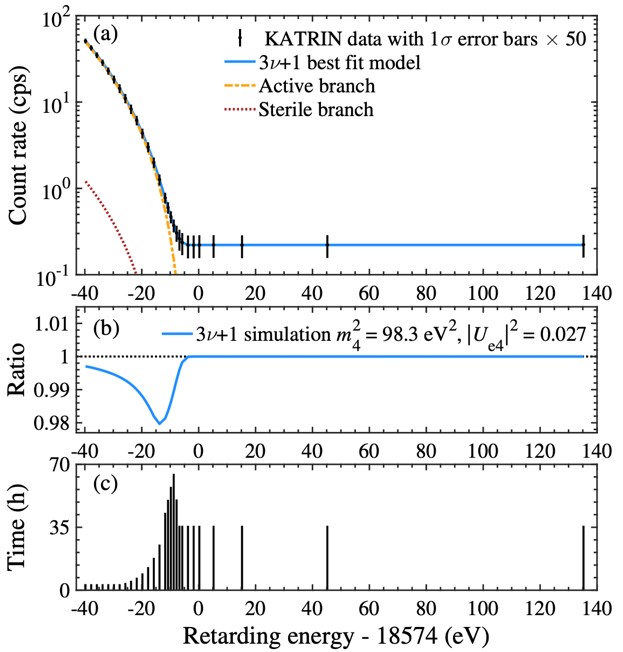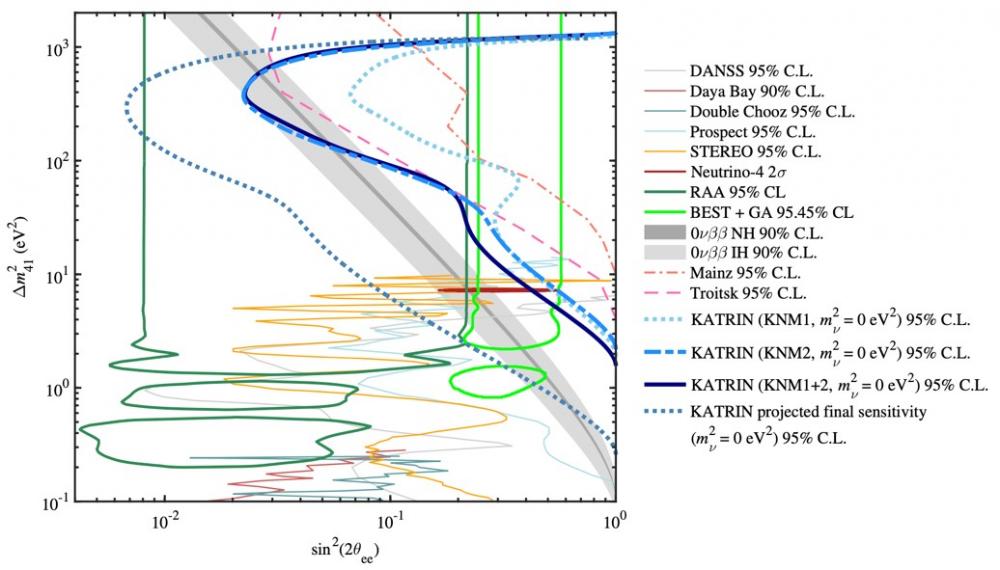The KATRIN collaboration has just recently reported a new upper limit of 0.8 eV/c2 on the mass of neutrinos. The KATRIN spectrometer also has a strong potential to search for new, so-called "sterile" neutrinos, based on a fine analysis of the tritium beta decay spectrum. The collaboration has just published its new results in Physical Review D based on the first two data campaigns acquired in 2019. This work reveals no evidence of a fourth neutrino, and KATRIN may well be a key player in clarifying the anomalies observed by some neutrino oscillation experiments over the past 20 years or so.
The international KATRIN experiment, which brings together 20 laboratories from 7 countries located at the Karlsruhe Institute of Technology (KIT) in Germany, is designed to measure the mass of neutrinos with a precision never achieved before. As such, it is presented as the most sensitive "balance" in the world. The principle of this device is illustrated in figure 2. Nearly one hundred billion electrons are emitted each second by the tritium source. As many electron antineutrinos are also emitted (one electron and one antineutrino per decay) but are not detected. The spectrometer, represented on figure 1, filters the electrons whose energy is close to the maximum energy of the decay (18.6 keV). A fine analysis of the electron energy distribution can be related to the properties of neutrinos thanks to the conservation laws of momentum and energy.

Figure 2: diagram of the KATRIN installation. A gas source contains di-tritium molecules (3H-3H), whose nuclei decay by beta radioactivity into helium 3 (3He) to emit electrons (e-) and electron antineutrinos. The electrons are transported to the spectrometer, which selects those whose energy exceeds a predefined value (called retarding potential) before they reach the detector. By varying the value of the retarding potential, the energy spectrum of the electrons can be reconstructed thanks to a pixelated detector located at the end of the spectrometer, with an energy resolution of 3 eV. The analysis of this spectrum makes it possible to determine the mass of the neutrino and to search for hypothetical sterile neutrinos. Credit: The KATRIN collaboration (KIT).
Three or more families of neutrinos?
Neutrinos are the most abundant particles in nature, except for photons (light particles). These tiny uncharged particles populate the entire universe, emanate from stars or supernovae, and are also produced during beta radioactive decays such as that of tritium. The current paradigm states that there are three neutrinos: electronic, muonic and tauic. However, this well-established picture may suffer from the atypical results of some experiments examining neutrino oscillations at short distances (see FM 2011 and FM 2019). If these are not experimental artifacts, then these few results are essentially interpreted as the existence of one or more additional neutrino families. These hypothetical neutrinos are called "sterile" in that they would interact with other particles only through gravity, whereas the three known flavors can also do so through the weak force. However, they could have an impact on the known neutrinos because of a singular property that these particles have in common: the ability to "oscillate". A sterile neutrino is likely to transform spontaneously into an electron, muon or tau neutrino, or vice versa. This is how sterile neutrinos would betray their existence...

Figure 3: (a) KATRIN data from the second measurement campaign (black dots) and best fit of a model including a sterile neutrino (denoted 3ν+1). The error bars are enhanced by a factor of 50 to improve visibility. The best fit of the model including a sterile neutrino only marginally improves the good agreement obtained without sterile neutrino (denoted 3ν). Therefore, no sterile neutrino is detected in these data. (b) Illustration of a sterile neutrino signal in KATRIN. The ratio of two simulated spectra in frames 3ν +1 and 3ν is shown and illustrates the shape of the sought signal. (c) Representation of the cumulative time spent at each value of the retarding potential of the integral measurement. Credit : The KATRIN collaboration.
Search for sterile neutrinos in KATRIN
It is possible to constrain the mass (denoted m4) and mixing (denoted |Ue4|2) of a hypothetical sterile neutrino with data from the KATRIN experiment. Indeed, a new mass state of the fourth neutrino would result in a distortion of the energy spectrum of the beta decay electrons. The signature would be a kinked break in the expected smooth spectrum of tritium electrons, as shown in a simulation presented in Figure 3 b.
New results from KATRIN
In a paper recently published in Physical Review D (Phys. Rev. D 105, 072004), the KATRIN collaboration reveals results from the search for light sterile neutrinos from the second Karlsruhe Tritium Neutrino (KATRIN) measurement campaign in 2019. Approaching the nominal activity, nearly 4 million electrons of tritium tritium decay are analyzed in an energy window extending to 40 eV below the "endpoint" at 18.57 keV.
The analysis is sensitive to a fourth eigenstate of mass m4 higher or in the order of 40 eV and the active-sterile mixture |Ue4|2 higher or in the order of 6 × 10-3. No sterile neutrino signal was observed, and the collaboration thus provides new exclusion contours for m42 and |Ue4|2 at 95% L.C. which are presented in Figure 4 below.
The new KATRIN results provide much tighter constraints than the previous Mainz and Troitsk beta decay experiments. These new results are furthermore combined with those from the first KATRIN measurement campaign (see FM 2020).
The net is tightening but the situation is far from being clarified
The KATRIN searches are complementary to the experiments conducted near the reactors. These new data improve the exclusion limits set by the short-range oscillation experiments for Δm412 higher or in the order of 10 eV2, led by the Stereo experiment. Furthermore, this new KATRIN study is in tension with the emergence of a sterile neutrino signal claimed by Neutrino-4 (this controversial result is also denied by the Stereo and Prospect experiments). The large Δm412 solutions of the reactor anomaly and the gallium anomalies (Gallex/Sage experiments and the recent BEST experiment) are partly ruled out.
While a clarification of the reactor anomalies could be anticipated in the near future following the building up of increasing beams of evidence incriminating the prediction of neutrino fluxes emitted by nuclear reactors, the Gallium anomaly has recently been reaffirmed in 2021 by the BEST collaboration. Now only a fairly heavy sterile neutrino (Δm412 = 10-20 eV2) with a large mixing could reconcile the data set.
KATRIN thus becomes the leading ongoing laboratory experiment that is particularly sensitive to relevant solutions still non-excluded through robust spectral shape analysis, and largely free of systematic effects in the range of mixing angles sought.
What the future holds for KATRIN
These new results still use only a modest fraction of the data that will be available at the end of the experiment in 2024. Systematic uncertainties and background noise have already been largely reduced for data acquired from the year 2020 onwards. An evaluation of the final sensitivity of KATRIN (1000 days), presented in figure 4, shows that the region of interest of the reactor and gallium anomalies will thus be fully examined by the year 2025.
Contact: Thierry Lasserre
The role of IRFU
At the IRFU particle physics department, Thierry Lasserre coordinated this analysis in collaboration with the Max Planck Institut für Physik (Munich) and co-coordinated this publication for the KATRIN collaboration.
• The ultimate constituents of matter › Neutrino Physics
• The Particle Physics Division





